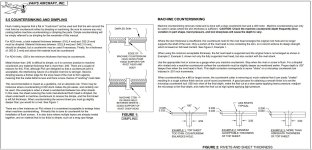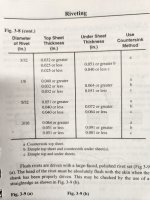HiPlanesDrifter
Member
So this has me a bit baffled. Horizontal elevator plans, Page 09-10, step 4 has you to countersink the rear spar on the holes which are common to the trim tab hinge.
http://www.vansaircraft.com/pdf/revisions/RV-14/09.pdf
The rear spar is only .032 thick. I have not proceeded yet, but under very careful examination, it appears the countersink would be very slightly too deep, causing a knife edge around the inside of the hole.
I do realize that section 5.5 does say you can countersink .032 thickness material as shown here:
"For AD3 rivets, a total material thickness between .016 [.4 mm] and .032 [.8 mm] must be dimpled. Material thickness between .032 [.8 mm] and .040 [1.0 mm],should be dimpled, but a countersink may be used if necessary. Finally, for a thickness of .050 [1.3 mm] and above the material must be countersunk."
So .032 is on the very low end.
I am very new at all this, and the only other time I have encountered needing to recess holes associated with hinges was on the tool box practice kit. Interesting, the lid is also .032 thick, and it had you to dimple it and the hinge for the flush rivets.
I hate the thought of going against the plans, but have any other builders entertained dimpling the .032 spar at the hinge rivet holes rather than countersinking, thus avoiding any potential knife edge? Perhaps they don't want us dimpling the hinge causing weakness or misalignment of some kind???
Thanks!
Chuck
http://www.vansaircraft.com/pdf/revisions/RV-14/09.pdf
The rear spar is only .032 thick. I have not proceeded yet, but under very careful examination, it appears the countersink would be very slightly too deep, causing a knife edge around the inside of the hole.
I do realize that section 5.5 does say you can countersink .032 thickness material as shown here:
"For AD3 rivets, a total material thickness between .016 [.4 mm] and .032 [.8 mm] must be dimpled. Material thickness between .032 [.8 mm] and .040 [1.0 mm],should be dimpled, but a countersink may be used if necessary. Finally, for a thickness of .050 [1.3 mm] and above the material must be countersunk."
So .032 is on the very low end.
I am very new at all this, and the only other time I have encountered needing to recess holes associated with hinges was on the tool box practice kit. Interesting, the lid is also .032 thick, and it had you to dimple it and the hinge for the flush rivets.
I hate the thought of going against the plans, but have any other builders entertained dimpling the .032 spar at the hinge rivet holes rather than countersinking, thus avoiding any potential knife edge? Perhaps they don't want us dimpling the hinge causing weakness or misalignment of some kind???
Thanks!
Chuck
Last edited:







